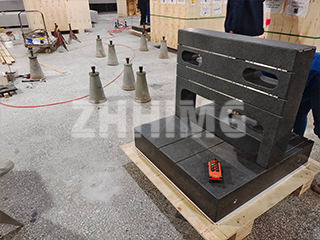If you’re in industries like manufacturing, metrology, or engineering that rely on ultra-precise measurement and workpiece positioning, you’ve likely encountered granite surface plates. But have you ever wondered why grinding is a non-negotiable step in their production? At ZHHIMG, we’ve mastered the art of granite surface plate grinding to deliver products that meet global precision standards—and today, we’re breaking down the process, the science behind it, and why it matters for your operations.
The Core Reason: Uncompromised Precision Starts with Grinding
Granite, with its natural density, wear resistance, and low thermal expansion, is the ideal material for surface plates. However, raw granite blocks alone can’t meet the strict flatness and smoothness requirements of industrial use. Grinding eliminates imperfections (like uneven surfaces, deep scratches, or structural inconsistencies) and locks in long-term precision—something no other processing method can achieve as reliably.
Crucially, this entire grinding process takes place in a temperature-controlled room (constant temperature environment). Why? Because even tiny temperature fluctuations can cause granite to expand or contract slightly, altering its dimensions. After grinding, we take an extra step: letting the finished plates sit in the constant-temperature room for 5-7 days. This “stabilization period” ensures any residual internal stress is released, preventing precision from “bouncing back” once the plates are put into use.
ZHHIMG’s 5-Step Grinding Process: From Rough Block to Precision Tool
Our grinding workflow is designed to balance efficiency with absolute accuracy—each step builds on the last to create a surface plate you can trust for years.
① Coarse Grinding: Laying the Foundation
First, we start with coarse grinding (also called rough grinding). The goal here is to shape the raw granite block into its final form, while controlling two key factors:
- Thickness: Ensuring the plate meets your specified thickness requirements (no more, no less).
- Basic Flatness: Removing large irregularities (like bumps or uneven edges) to bring the surface within a preliminary flatness range. This step sets the stage for more precise work later.
② Semi-Fine Grinding: Erasing Deep Imperfections
After coarse grinding, the plate may still have visible scratches or small indentations from the initial process. Semi-fine grinding uses finer abrasives to smooth these out, refining the flatness further. By the end of this step, the plate’s surface is already approaching a “workable” level—no deep flaws, just minor details left to address.
③ Fine Grinding: Boosting Precision to a New Level
Now, we shift to fine grinding. This step focuses on elevating flatness accuracy—we narrow down the flatness tolerance to a range that’s close to your final requirement. Think of it as “polishing the foundation”: the surface becomes smoother, and any tiny inconsistencies from semi-fine grinding are eliminated. At this stage, the plate is already more precise than most non-ground granite products on the market.
④ Hand Finishing (Precision Grinding): Achieving Exact Requirements
Here’s where ZHHIMG’s expertise truly shines: manual precision grinding. While machines handle the earlier steps, our skilled technicians take over to refine the surface by hand. This allows us to target even the smallest deviations, ensuring the plate meets your exact precision needs—whether that’s for general measurement, CNC machining, or high-end metrology applications. No two projects are the same, and hand finishing lets us adapt to your unique specifications.
⑤ Polishing: Enhancing Durability & Smoothness
The final step is polishing. Beyond making the surface look sleek, polishing serves two critical purposes:
- Increasing Wear Resistance: A polished granite surface is harder and more resistant to scratches, oil, and corrosion—extending the plate’s lifespan.
- Minimizing Surface Roughness: The lower the surface roughness value (Ra), the less likely dust, debris, or moisture will stick to the plate. This keeps measurements accurate and reduces maintenance needs.
Why Choose ZHHIMG’s Ground Granite Surface Plates?
At ZHHIMG, we don’t just grind granite—we engineer precision solutions for your business. Our grinding process isn’t just a “step”; it’s a commitment to:
- Global Standards: Our plates meet ISO, DIN, and ANSI precision requirements, suitable for export to any market.
- Consistency: The 5-7 day stabilization period and hand-finishing step ensure every plate performs the same, batch after batch.
- Customization: Whether you need a small bench-top plate or a large floor-mounted one, we tailor the grinding process to your size, thickness, and precision needs.
Ready to Get a Precision Granite Surface Plate?
If you’re looking for a granite surface plate that delivers reliable accuracy, long-lasting durability, and meets your industry’s strict standards, ZHHIMG is here to help. Our team can walk you through material options, precision levels, and lead times—just send us an inquiry today. Let’s build a solution that fits your workflow perfectly.
Contact ZHHIMG now for a free quote and technical consultation!
Post time: Aug-25-2025

